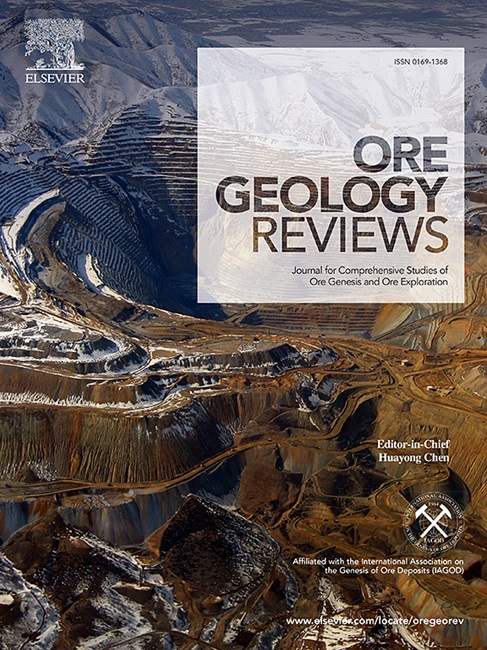利用多源遥感数据在缅甸佤邦北部进行金矿勘探
IF 3.6
2区 地球科学
Q1 GEOLOGY
引用次数: 0
摘要
金矿开采在许多国家的经济发展中起着至关重要的作用,缅甸以其丰富的矿藏而闻名。初步勘查结果表明,缅甸佤邦北部地区是找金远景区。然而,目前缺乏详细的地质调查,矿产勘查目标范围尚不明确。遥感技术对跨界矿产勘查具有重要的指导意义。本研究开发了一种多源遥感方法来圈定缅甸佤邦北部卡林型金矿床。利用Landsat 8 OLI和ASTER数据解释断层信息。ASTER数据采用iCrosta方法提取铁染和硅化蚀变信息。基于谷歌Earth Engine (GEE)平台,采用随机森林方法获取岩性分类信息。综合分析遥感数据提取的断层、蚀变和岩性信息,圈定了2个金矿找矿目标区。以1号勘探靶区为例,利用基于光谱角法的中国ZY1-02D高光谱数据进一步提取黄铁矿信息,进一步缩小勘探靶区范围。通过在缩小的找矿靶区进行野外调查和岩相分析,确实确定了金矿化,证明了多源遥感数据找矿方法的有效性。该研究可为世界其他类似地质环境下的矿产资源勘查提供重要参考。本文章由计算机程序翻译,如有差异,请以英文原文为准。

Gold exploration using multi-source remote sensing data in the northern part of the Wa State, Myanmar
Gold mining plays a vital role in the economic development of many countries, and Myanmar is known for its rich mineral deposits. Preliminary exploration suggests that the northern region of Wa State in Myanmar is a prospective area for gold mineralization. However, detailed geological investigations are currently lacking, and the target range for mineral exploration remains unclear. Remote sensing technology can provide significant guidance for cross-border mineral exploration. This study developed a multi-source remote sensing methodology to delineate Carlin-type gold deposits in northern Wa State, Myanmar. Landsat 8 OLI and ASTER data were used to interpret fault information. ASTER data were employed to extract iron-stained and silicified alteration information using the iCrosta method. Based on the Google Earth Engine (GEE) platform, lithological classification information was obtained using the random forest method. By comprehensively analyzing the fault, alteration, and lithological information extracted from remote sensing data, two gold exploration target areas were delineated. Taking the No. 1 exploration target area as an example, the pyrite information was further extracted by China’s ZY1-02D hyperspectral data based on spectral angle method, the scope of exploration target area is further narrowed. Through field investigations and petrographic analysis conducted in the narrowed exploration target areas, gold mineralization was indeed identified, demonstrating the effectiveness of the mineral exploration methodology based on multi-source remote sensing data. This study can provide an important reference for the exploration of mineral resources in other similar geological settings worldwide.
求助全文
通过发布文献求助,成功后即可免费获取论文全文。
去求助
来源期刊

Ore Geology Reviews
地学-地质学
CiteScore
6.50
自引率
27.30%
发文量
546
审稿时长
22.9 weeks
期刊介绍:
Ore Geology Reviews aims to familiarize all earth scientists with recent advances in a number of interconnected disciplines related to the study of, and search for, ore deposits. The reviews range from brief to longer contributions, but the journal preferentially publishes manuscripts that fill the niche between the commonly shorter journal articles and the comprehensive book coverages, and thus has a special appeal to many authors and readers.
 求助内容:
求助内容: 应助结果提醒方式:
应助结果提醒方式:


